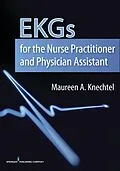It is vital for NPs and PAs to be highly skilled in EKG interpretation to correctly identify high-risk patients and to make appropriate clinical decisions. This reference book is the first to present a comprehensive, multifaceted approach to EKG interpretation, covering all major topics required for expertise in this area.
Based on a physiologic approach that facilitates in-depth understanding, the text includes clinical scenarios that may be seen in practice, and firmly links the information found in the EKG printout to the patientís symptoms. It clearly presents the gamut of requisite topics in EKG interpretationófrom basic to complexóincluding topics not customarily addressed in depth, such as supraventricular tachycardias and pacemaker EKGs. The bookís multifaceted approach to EKG interpretation is enhanced with new approaches and recommendations, charts, and tables. Review questions at the end of each chapter enable students to identify problem areas. This book helps NPs, PAs, and other health professionals master their EKG interpretation skills and apply them with confidence every day.
Key Features:- Presents the first comprehensive guide to EKG interpretation
- Based on a physiological approach to promote in-depth understanding
- Connects the patientís presenting symptoms to EKG interpretation
- Uses charts, graphs, and printouts to support class discussion
- Includes end-of-chapter review questions
Autorentext
Maureen A. Knechtel, MPAS, PA-C, received a bachelor's degree in health sciences and a master's degree in physician assistant studies from Duquesne University in Pittsburgh, Pennsylvania. She has spent her clinical career as a physician assistant specializing in general cardiology and cardiac electrophysiology. She teaches EKG recognition and interpretation to both physician assistants and nurse practitioners and has been a guest lecturer nationally and locally on topics including EKG interpretation, chronic angina, ischemic heart disease in women, hypertension, and mixed hyperlipidemia. Ms. Knechtel is a fellow member of the American Academy of Physician Assistants and the Tennessee Academy of Physician Assistants, and is currently a principal faculty member and assistant professor with the Milligan College Physician Assistant Program in northeast Tennessee.
Inhalt
"
Part I. Basics of Cardiac Physiology and Relationship to the EKG Rhythm Output
1. Introduction to the EKG and Anatomy of the Electrical Conduction System
2. Defining the Intervals
3. Lead Review
Part II. Interpreting the 12 Lead EKG
4. Rate
5. Rhythm
6. Axis
7. Heart Block
8. Ischemia and Infarction
Part III. Commonly Occurring Arrhythmias and EKG Findings
9. Supraventricular Tachycardia
10. Ventricular Arrhythmias
11. Paced EKGs
12. Drug Effects on the EKG
13. Left Ventricular Hypertrophy, Electrolyte Effects, and Other Miscellaneous Findings on EKG
Part IV. Clinical Application
14. Applying EKG Skills to Clinical Practice
"